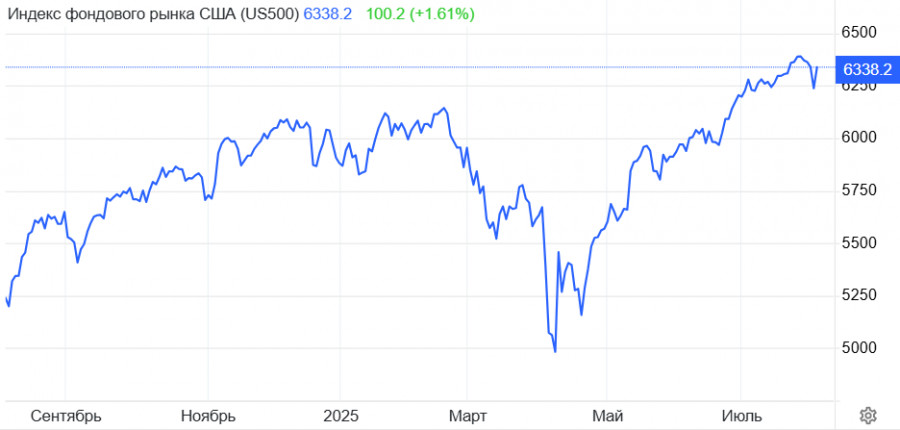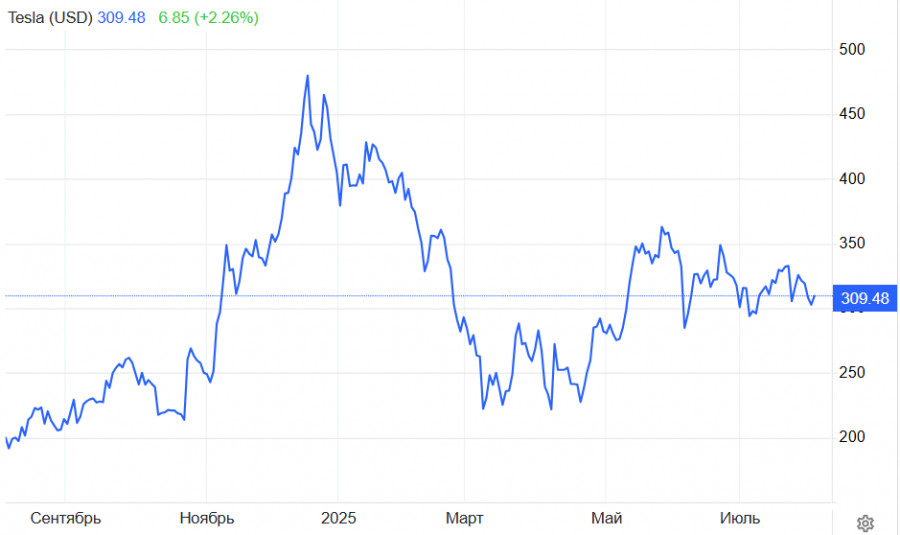US indices are once again charging toward record highs. After a tense week, when the market stumbled over trade wars and a weak labor market, the momentum is shifting back in favor of bulls. The key factor is a wave of corporate earnings, where positive surprises notably outweigh the negative.
Yesterday ended with a brilliant result for bulls: the S&P 500 rose by 1.47%, the Nasdaq added 1.95%, and the Dow climbed by 1.34%. At the core of the rally are expectations of monetary policy easing following disappointing jobs data for July.
Traders are now almost fully pricing in a Fed rate cut in September. This has revived risk appetite and helped equities reclaim nearly all of the previous week's losses.
The key short-term catalyst remains corporate earnings from tech and AI companies. Palantir jumped by 4% after posting quarterly results that exceeded forecasts and sharply raised its full-year guidance. This bolstered confidence in the artificial intelligence sector, which has been the primary engine of Nasdaq's growth in recent weeks.
Investors are closely watching upcoming earnings reports. On deck today: AMD, Pfizer, Snap, Rivian, Yum! Brands — each release from this lineup could reshape short-term expectations for their respective sectors and the broader market.
Disappointments have not vanished entirely: Hims & Hers Health plummeted by 13% after weak revenue data. The market is becoming increasingly selective — a poor quarter is now punished far more severely than before.
Key fundamental drivers
Optimism is fueled by expectations of Fed policy easing, but fundamental risks remain — trade wars, signs of overheating in certain sectors, and persistent fragility in the US macroeconomy.
The key question of the week is whether IT giants and Big Pharma will confirm the strength of the recovery, or whether the market will begin a new rotation into defensive assets.
Technical picture: resistance zone back in focus
From a technical standpoint, the market has quickly returned to its previous resistance zones. In premarket trading, the S&P 500 is hovering around 6,340, the upper bound of the July range, close to all-time highs (6,380–6,427).
A breakout above this zone would pave the way for new records, but there is already caution at current levels: bulls are trying to build momentum, but any earnings disappointment could trigger a pullback to the 6,300 support level, and in case of negative news — down to 6,250.
The Nasdaq 100 is trading near 23,250, with resistance still in the 23,300–23,400 area. If the index manages to consolidate above this zone, it will open up potential for continued growth toward absolute record highs.
However, a "false breakout" scenario remains highly likely. All eyes are on the earnings reports from AMD, Snap, and Pfizer as any surprises could quickly shift the market's direction.
Current structure: The market is showing a classic pattern of short, sharp corrections followed by aggressive rebounds on positive news. Breadth remains far from ideal: the main moves are still driven by the 5-7 largest companies, and sector rotation could become the catalyst for new volatility as early as this week.
What about Tesla?
Tesla is back in the spotlight after the board of directors approved a new compensation package for Elon Musk worth $29 billion. The market responded positively to the move. The stock rose by 2.19%, consolidating around the $310 level.
Why market responds with gains
The new stock option package for Musk effectively secures his vested interest in the company's continued development, reducing the risk of his departure or strategic distraction.
Investors interpret this as a long-term signal: Musk will be incentivized to increase the company's value, aggressively scale technologies, and strengthen Tesla's position in the electric vehicle and AI markets, including robotaxis, neural networks, and autonomous driving.
After a prolonged stagnation through spring and summer, Tesla shares have found new momentum, driven by expectations of strong second-half earnings, rising interest in AI, and the potential of new products such Cybertruck, next-gen batteries, and software.
However, risks remain:
Competition in the EV segment is intensifying — Chinese manufacturers, General Motors, and BYD are rapidly closing in.
Tesla's valuation remains expensive even by tech sector standards (its forward P/E is above the sector average).
The stock remains highly volatile: any earnings miss or delays in product launches often trigger swift corrections of 7-15% within days.
Any new regulatory surprises (tariffs, US-China duties) could impact delivery dynamics.
Technical picture: risk zones and growth potential
Following the recent rally, Tesla has broken out of its local sideways range and consolidated above the key resistance level of $300. On the daily chart, the structure is shifting toward a moderately bullish formation.
Nearest resistance: $318–320 (upper boundary of the July range, a critical profit-taking zone); above that — the target is $340 (spring highs).
Support: $300–303 (formerly resistance, now a buy-the-dip zone); below that — $285-288 (recent weekly lows).
Worth buying?
If you are prepared to hold the position in the medium term (3-6 months) and tolerate volatility, buying Tesla at $310 is reasonably justified, with upside targets at $320–340 and a stop-loss order no lower than $295–297.














